

Numbness in the toes can be temporary or long term. Chronic toe numbness can impede your ability to walk and increase the chances of wounds and other injuries. When the nerves in your toes are compressed, damaged, or irritated the result is often a feeling of numbness and tingling. Some people experience these symptoms after long bouts of high-impact exercise or other physical activity. In these cases, the numbness generally subsides when the activity is over. Other causes of numbness in the toes can be the result of a serious neurological event, such as a seizure or stroke. More common causes include chronic alcohol abuse, Charcot-Marie-Tooth disease, peripheral artery disease (PAD), or diabetic neuropathy. Nerve compression syndromes, like Morton’s neuroma or tarsal tunnel syndrome, may also cause toe numbness. People with chronic toe numbness would do well to practice good foot hygiene and have frequent foot examinations with a podiatrist who can best detect the underlying cause and offer treatment options.
Toe pain can disrupt your daily activities. If you have any concerns, contact the podiatrists of The Foot & Ankle Center of New Jersey. Our doctors can provide the care you need to keep you pain-free and on your feet.
What Causes Toe Pain?
Most severe toe pain is caused due to a sports injury, trauma from dropping something heavy on the toe, or bumping into something rigid. Other problems can develop over time for various reasons.
Toe pain can be caused by one or more ailments. The most common include:
When to See a Podiatrist
Diagnosis
In many cases the cause of toe pain is obvious, but in others, a podiatrist may want to use more advanced methods to determine the problem. These can range from simple visual inspections and sensation tests to X-rays and MRI scans. Prior medical history, family medical history, and any recent physical traumatic events will all be taken into consideration for a proper diagnosis.
Treatment
Treatments for toe pain and injuries vary and may include shoe inserts, padding, taping, medicines, injections, and in some cases, surgery. If you believe that you have broken a toe, please see a podiatrist as soon as possible.
If you have any questions please feel free to contact our office located in Paramus, NJ . We offer the newest diagnostic tools and technology to treat your foot and ankle needs.
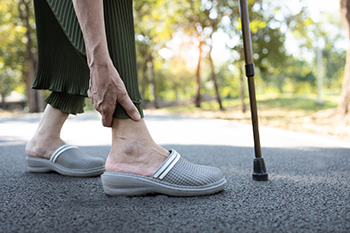
Each foot consists of 26 bones, as well as numerous ligaments, tendons, and muscles. As the aging process occurs, the feet can become weakened by daily stress, but there are measures that can be taken to maintain the health of the feet. These include washing and drying the feet thoroughly, especially between the toes, and trimming the toenails correctly, which may help to prevent ingrown toenails from developing. Blood circulation may be improved, which can contribute to having good foot health. This is accomplished by frequently practicing a gentle exercise routine. It is also beneficial to check the soles of the feet for existing cuts, bruises, and scrapes that may have developed, in addition to wearing socks that can absorb sweat. The feet can feel the most comfortable in shoes with a lower heel, made of breathable materials, and having adequate cushioning that may help to balance the weight of the body. If you have questions and would like more information about how to take care of elderly feet, please confer with a podiatrist.
Everyday foot care is very important to prevent infection and other foot ailments. If you need your feet checked, contact the podiatrists from The Foot & Ankle Center of New Jersey. Our doctors can provide the care you need to keep you pain-free and on your feet.
Everyday Foot Care
Often, people take care of their bodies, face and hair more so than they do for their feet. But the feet are a very important aspect of our bodies, and one that we should pay more attention to. Without our feet, we would not be able to perform most daily tasks.
It is best to check your feet regularly to make sure there are no new bruises or cuts that you may not have noticed before. For dry feet, moisturizer can easily be a remedy and can be applied as often as necessary to the affected areas. Wearing shoes that fit well can also help you maintain good foot health, as well as making it easier to walk and do daily activities without the stress or pain of ill-fitting shoes, high heels, or even flip flops. Wearing clean socks with closed shoes is important to ensure that sweat and bacteria do not accumulate within the shoe. Clean socks help to prevent Athlete’s foot, fungi problems, bad odors, and can absorb sweat.
If you have any questions please feel free to contact our office located in Paramus, NJ . We offer the newest diagnostic and treatment technologies for all your foot and ankle needs.

A bunion is a foot deformity that manifests itself as a bony bump near the joint of the big toe. Importantly, bunions might also form at the base of the pinky toe as well, which are known as bunionettes. If you have a bunion, you may experience any number of symptoms, including swelling at the affected joint, redness, and possibly pain. If you have a severe case of bunions that does not respond to other forms of treatment, undergoing a surgical procedure to treat your bunions may possibly be an option. Such a procedure typically requires up to six months of recovery time, and it is primarily concerned with reducing pain and bringing the metatarsophalangeal joint back into alignment. The different types of relevant surgical procedures are known as an osteotomy, arthrodesis, and exostectomy, among others. If you have bunions and think you may be a candidate for bunion surgery, contact a podiatrist today.
If you are suffering from bunions, contact the podiatrists of The Foot & Ankle Center of New Jersey. Our doctors can provide the care you need to keep you pain-free and on your feet.
What Is a Bunion?
A bunion is formed of swollen tissue or an enlargement of boney growth, usually located at the base joint of the toe that connects to the foot. The swelling occurs due to the bones in the big toe shifting inward, which impacts the other toes of the foot. This causes the area around the base of the big toe to become inflamed and painful.
Why Do Bunions Form?
Genetics – Susceptibility to bunions are often hereditary
Stress on the feet – Poorly fitted and uncomfortable footwear that places stress on feet, such as heels, can worsen existing bunions
How Are Bunions Diagnosed?
Doctors often perform two tests – blood tests and x-rays – when trying to diagnose bunions, especially in the early stages of development. Blood tests help determine if the foot pain is being caused by something else, such as arthritis, while x-rays provide a clear picture of your bone structure to your doctor.
How Are Bunions Treated?
If you have any questions, please feel free to contact our office located in Paramus, NJ . We offer the newest diagnostic and treatment technologies for all your foot care needs.

A blister is a fluid-filled bubble that forms on the skin. The fluid can be clear or contain blood. If blisters develop between the toes, it can cause pain, particularly the longer one spends on their feet. The two main types of blisters on or between the toes are those from friction and those not due to friction. Friction or pinch blisters are more common and result from toes repeatedly rubbing against each other or against the shoe lining, irritating the skin. These are related to the shape and alignment of toes, fit of shoe, and usually form near the tip of the toe or by the base of the toe. Sweaty toes are more apt to lead to friction blisters. Blisters not due to friction can develop from an infection (like athlete’s foot), a skin condition, a sunburn, or an allergy. Both types of blisters might look the same. However, the location of the blister and what causes it can help determine the type. Non-friction blisters should be evaluated by a podiatrist. With both types of blisters, good foot hygiene can help prevent them. Popping or picking at blisters should be avoided as broken skin can attract bacteria, which can cause an infection. If you have a blister on or between your toes and you are not sure of the cause, it appears infected, or if it is not healing well, contact a podiatrist for an evaluation and treatment options.
Blisters are prone to making everyday activities extremely uncomfortable. If your feet are hurting, contact the podiatrists of The Foot & Ankle Center of New Jersey. Our doctors can provide the care you need to keep you pain-free and on your feet.
Foot Blisters
Foot blisters develop as a result of constantly wearing tight or ill-fitting footwear. This happens due to the constant rubbing from the shoe, which can often lead to pain.
What Are Foot Blisters?
A foot blister is a small fluid-filled pocket that forms on the upper-most layer of the skin. Blisters are filled with clear fluid and can lead to blood drainage or pus if the area becomes infected.
How Do Blisters Form?
Blisters on the feet are often the result of constant friction of skin and material, usually by shoe rubbing. Walking in sandals, boots, or shoes that don’t fit properly for long periods of time can result in a blister. Having consistent foot moisture and humidity can easily lead to blister formation.
Prevention & Treatment
It is important to properly care for the affected area in order to prevent infection and ease the pain. Do not lance the blister and use a Band-Aid to provide pain relief. Also, be sure to keep your feet dry and wear proper fitting shoes. If you see blood or pus in a blister, seek assistance from a podiatrist.
If you have any questions, please feel free to contact our office located in Paramus, NJ . We offer the newest diagnostic and treatment technologies for all your foot care needs.
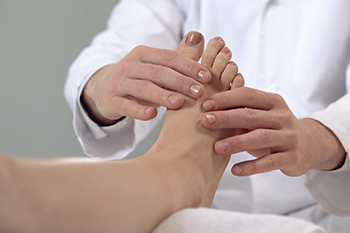
High heels are undoubtedly a significantly popular footwear fashion choice made by women across the world. Despite their popularity, excessive use of high heels can wreak havoc on your feet. Due to their structure which features a narrow toe box, high heels can cause a variety of foot ailments that you ought to be aware of. Besides just causing foot pain, high heels can also lead to lower back pain and knee pain. In particular, high heels have a damaging tendency of making one susceptible to ankle sprains. When high heels are worn on uneven surfaces (i.e. cobblestone), the chances of falling or tripping increase markedly. If an individual falls while wearing high heels, they may land awkwardly on their ankle or twist it in some way, eventually suffering from an ankle sprain. Falling in this way might also lead to broken ankles and perhaps bruised knees. To avoid suffering these injuries, one might consider walking with high heels only on even surfaces. Additionally, one could consider limiting the time that they spend wearing this kind of footwear. It is simply an unfortunate truth that, like flip flops, high heels can be a potentially damaging kind of footwear. If you are worried about how high heels affect your feet, consult with your local podiatrist.
High heels have a history of causing foot and ankle problems. If you have any concerns about your feet or ankles, contact the podiatrists from The Foot & Ankle Center of New Jersey. Our doctors can provide the care you need to keep you pain-free and on your feet.
Effects of High Heels on the Feet
High heels are popular shoes among women because of their many styles and societal appeal. Despite this, high heels can still cause many health problems if worn too frequently.
Which Parts of My Body Will Be Affected by High Heels?
What Kinds of Foot Problems Can Develop from Wearing High Heels?
How Can I Still Wear High Heels and Maintain Foot Health?
If you want to wear high heeled shoes, make sure that you are not wearing them every day, as this will help prevent long term physical problems. Try wearing thicker heels as opposed to stilettos to distribute weight more evenly across the feet. Always make sure you are wearing the proper shoes for the right occasion, such as sneakers for exercising. If you walk to work, try carrying your heels with you and changing into them once you arrive at work. Adding inserts to your heels can help cushion your feet and absorb shock. Full foot inserts or metatarsal pads are available.
If you have any questions please feel free to contact our office located in Paramus, NJ . We offer the newest diagnostic and treatment technologies for all your foot and ankle needs.
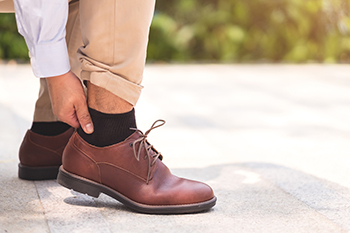 Standing all day while working can lead to pain, swelling, and long-term foot complications. That is why it is vital to use scheduled work breaks to elevate your feet, and take other precautionary measures to mitigate the damages working on your feet can cause to your feet and ankles. The best line of defense starts with proper footwear. Invest in a good pair (or two) of work shoes that provide proper support in the ankle and heels, plenty of cushioning, and stability. Your podiatrist can recommend other specific features to look for, based on the structure of your feet. They can also create custom orthotics to address any specific structural or alignment issues you may have which may cause pain and stress in other areas of your body. There are certain stretches and exercises your podiatrist may also suggest to stretch your feet, calf muscles and Achilles tendon. They may also recommend compression stockings to help stimulate circulation in your feet and reduce swelling. After a long day standing on the job, it is important to help your feet and ankles recover. Pamper your feet by soaking them in a warm bath. Massaging your feet and/or icing them may help to reduce swelling and soothe sore muscles. Contact a podiatrist near you to learn more about protecting your hard working feet on the job.
Standing all day while working can lead to pain, swelling, and long-term foot complications. That is why it is vital to use scheduled work breaks to elevate your feet, and take other precautionary measures to mitigate the damages working on your feet can cause to your feet and ankles. The best line of defense starts with proper footwear. Invest in a good pair (or two) of work shoes that provide proper support in the ankle and heels, plenty of cushioning, and stability. Your podiatrist can recommend other specific features to look for, based on the structure of your feet. They can also create custom orthotics to address any specific structural or alignment issues you may have which may cause pain and stress in other areas of your body. There are certain stretches and exercises your podiatrist may also suggest to stretch your feet, calf muscles and Achilles tendon. They may also recommend compression stockings to help stimulate circulation in your feet and reduce swelling. After a long day standing on the job, it is important to help your feet and ankles recover. Pamper your feet by soaking them in a warm bath. Massaging your feet and/or icing them may help to reduce swelling and soothe sore muscles. Contact a podiatrist near you to learn more about protecting your hard working feet on the job.
While working on the feet, it is important to take the proper care of them. For more information about working on your feet, contact the podiatrists from The Foot & Ankle Center of New Jersey. Our doctors will treat your foot and ankle needs.
Working on Your Feet
Standing on your feet for long periods of time can cause stress and pain in your feet. Your whole body may experience change in terms of posture, back pain, bunions, callouses and or plantar warts. There are ways to avoid these conditions with proper foot care, smart choices and correct posture.
Positive Changes
Negative heeled shoe – Choosing this shoe type places the heel slightly lower than the ball of the foot. These are great for overall foot health. Find shoes that fit you correctly.
Go barefoot – Our feet were not designed to be enclosed for all hours of the day. Try to periodically expose your feet to air.
Eliminate Pain
Foot Exercises – Performing simple exercises, incorporating yoga and doing stretches are beneficial. This will allow increased blood flow to the area and muscles of the foot.
Achilles tendon – Stretching the foot out flat on the floor will relax the calf muscles and tendon. These exercises can be performed almost anywhere. Make sure you add these exercises to your daily regimen.
With a little bit of this information and knowing more about foot health, you will notice changes. Foot stretches and proper footwear will help with pain and prevent further issues.
If you have any questions please feel free to contact our office located in Paramus, NJ . We offer the newest diagnostic and treatment technologies for all your foot and ankle needs.
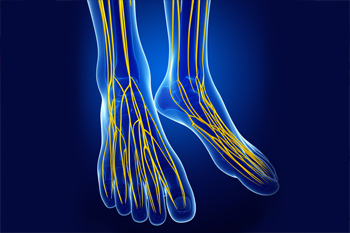
There is a narrow passageway called the tarsal tunnel, which is located on the inside of the ankle. The tibial nerve, starting at the back of the leg, runs down through the tarsal tunnel, along with veins, arteries, and tendons. Because so many structures pass through the tarsal tunnel, the interior space is very confined. This space becomes even more constricted if an ankle injury occurs that causes inflammation or a swollen vein or tendon, or if a cyst develops within the tunnel. This can cause the tibial tendon to become squeezed, or compressed, and result in pain, burning, tingling, or numbness along the nerve’s path. This condition is known as tarsal tunnel syndrome. Flat feet, and inflammation due to arthritis and diabetes may also contribute to this condition developing. It is important to have tarsal tunnel syndrome diagnosed and treated as early as possible, not only to relieve pain and inflammation, but to avoid permanent nerve damage. A podiatrist can assess your condition and devise an appropriate treatment plan to get you on the road to recovery as soon as possible.
Tarsal tunnel syndrome can be very uncomfortable to live with. If you are experiencing tarsal tunnel syndrome, contact the podiatrists of The Foot & Ankle Center of New Jersey. Our doctors can provide the care you need to keep you pain-free and on your feet.
Tarsal Tunnel Syndrome
Tarsal tunnel syndrome, which can also be called tibial nerve dysfunction, is an uncommon condition of misfiring peripheral nerves in the foot. The tibial nerve is the peripheral nerve in the leg responsible for sensation and movement of the foot and calf muscles. In tarsal tunnel syndrome, the tibial nerve is damaged, causing problems with movement and feeling in the foot of the affected leg.
Common Cause of Tarsal Tunnel Syndrome
The Effects of Tarsal Tunnel Syndrome
A physical exam of the leg can help identify the presence of tarsal tunnel syndrome. Medical tests, such as a nerve biopsy, are also used to diagnose the condition. Patients may receive physical therapy and prescriptive medication. In extreme cases, some may require surgery.
If you have any questions please feel free to contact our office located in Paramus, NJ . We offer the newest diagnostic and treatment technologies for all your foot and ankle needs.
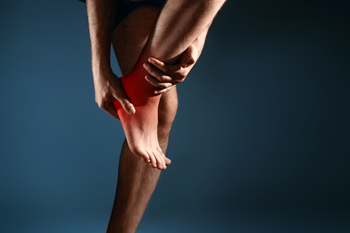
Compartment syndrome is a serious condition that can affect the overall health of your foot. A group of muscles, along with nerves and blood vessels, is contained in a band of tissue called a compartment. The fascia around the muscles does not expand, so if it sustains an injury it may bleed or swell. This causes pressure to build up, which cuts off the blood supply of nutrients and oxygen to the muscle. Muscles can become permanently damaged if not treated quickly. There are two types of compartment syndrome, acute and chronic. Acute compartment syndrome is usually the result of a fracture. It also can be caused by trauma, a bruised muscle, a severe sprain, or even a cast or bandage that is too tight. Chronic compartment syndrome is caused by repetitive activity, and is more common among runners, especially those over 40. It differs from the acute syndrome because the pressure occurs only during the activity and recedes when it stops. Chronic, also called long-term, compartment syndrome can affect activity and endurance, but rarely endangers the muscles. To confirm a diagnosis of compartment syndrome, please see a podiatrist for an examination.
Foot Pain
Foot pain can be extremely painful and debilitating. If you have a foot pain, consult with the podiatrists from The Foot & Ankle Center of New Jersey. Our doctors will assess your condition and provide you with quality foot and ankle treatment.
Causes
Foot pain is a very broad condition that could be caused by one or more ailments. The most common include:
Diagnosis
To figure out the cause of foot pain, podiatrists utilize several different methods. This can range from simple visual inspections and sensation tests to X-rays and MRI scans. Prior medical history, family medical history, and any recent physical traumatic events will all be taken into consideration for a proper diagnosis.
Treatment
Treatment depends upon the cause of the foot pain. Whether it is resting, staying off the foot, or having surgery; podiatrists have a number of treatment options available for foot pain.
If you have any questions, please feel free to contact our office located in Paramus, NJ . We offer the newest diagnostic and treatment technologies for all your foot care needs.